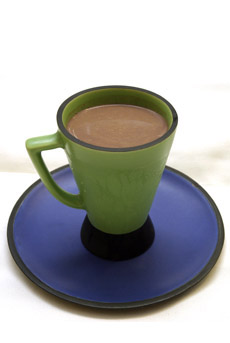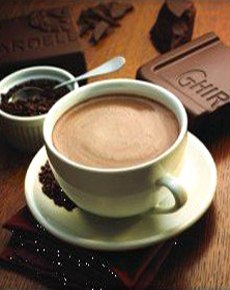Chocolate Glossary: A Glossary Of The Different Chocolate Types
Page 2: The History of Hot Chocolate
This is Page 2 of an 6-page article. Click on the red links below to visit other pages. This glossary is protected by copyright and cannot be reproduced in whole or part. You are welcome to link to it.
|
|
 Hot chocolate tastes even better in a pretty cup. Photo by Elton Lin | THE NIBBLE. Hot chocolate tastes even better in a pretty cup. Photo by Elton Lin | THE NIBBLE. |
In The Beginning
“Chocolate for eating” is a relatively new concept: only in 1847 was the chocolate bar invented. Prior to then, chocolate had always been a beverage. The idea of drinking a chocolate beverage dates back to 1500 B.C.E., when the Olmecs of the Central America domesticated cacao. Previously the fruit of the cacao tree had been eaten (it tastes like passionfruit); but at some point, the seeds, previously discarded like the seeds of most fruits, were found to have “magical” properties when roasted and ground into cocoa powder.
A new beverage was born.
The tomb of a Mayan ruler found in Guatemala, circa 500 C.E., contained more than a dozen pottery vessels, a few of which almost certainly contained residue of a drink made from cacao beans. However, this was not the hot chocolate with which we’re familiar today. Most likely, it would have contained finely-ground or pounded cacao beans, water, indigenous chiles and ground, toasted corn (maize). Other recipes might have included wine, honey and allspice. The temperature at which the Mayans drank their chocolate beverages is also a mystery; although based on accounts of the preparation, it was most likely tepid, or “room temperature.” Mayan and the Aztecs to whom they traded the beans drank chocolate as an aphrodisiac and a medicinal restorative. It was a ceremonial drink. But the Conquistadors found the recipe unpalatable, and when they brought the beans back to Spain to King Ferdinand and Queen Isabella, royal chefs promptly introduced ingredients to make it more palatable: sugar, rice, cinnamon, anise seed and black pepper. It was still a far cry from what most of us think of when we hear the words “drinking chocolate.”
|
|

Ghirardelli Premium Hot Cocoa: one of our favorite products in the budget category. It’s actually made of ground chocolate, so it should be calling itself a “hot chocolate” instead of a “cocoa.” Cocoas are made of cocoa powder, and have less cocoa butter (and richness) than hot chocolates. Photo courtesy Ghirardelli. |
| From New World To Old World
Chocolate was the drink of royals, aristocrats and wealthy merchants; the beans were so valuable they were used as currency. The same paradigm occurred once chocolate reached Europe: it took a couple of centuries to work its way down the socioeconomic ladder to physicians and the bourgeoisie.
Yes, chocolate was once considered medicinal, though not everyone approved of the beverage’s supposed health-giving or health-preserving properties. There were even debates over whether or not taking a cup of chocolate (which was served both iced and hot) was technically breaking a fast, a crucial consideration in a time when Roman Catholic religious fasts were taken seriously. If chocolate was merely a drink, it wouldn’t break the fast, but if it was judged to be a food, it could not be consumed during times of fast, including all of Lent, the hours between midnight and Holy Communion (which would probably have been celebrated during Mass in the morning), and any other times of fasting.
Clerics of all ranks weighed in on this critical subject, up to and including some Popes. Gregory XIII (1572-1588) ruled that chocolate did not break the fast, and other popes agreed. But some clergymen who were stricter in their interpretations attempted numerous bans of chocolate during fasts.
In 1645, Tomas Hurtado, who held a chair in theology at the University of Seville, judged that chocolate was a drink if made with water, but a food when milk or eggs were used in the preparation. By this we know that some chocolate was prepared with milk at least as early as the mid-17th century.
Continue To Page 2b: The Origin Of Cocoa
Go To The Article Index Above
|